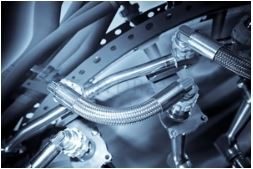Despite having been around for centuries, Hydraulic engineering is still dynamically evolving. Innovations and improvements emerge all the time. New products make hydraulic equipment smarter, smoother, and more powerful. The rise of digital technology and automation is changing the way industrial hydraulics work rapidly, too.
Here are the three emergent hydraulic trends that we’re most excited about this year.
1) Smarter Renewables Through Hybrid Hydraulic And Electromechanical Actuation
Getting renewable generators (such as solar voltaic panels and hydroelectric turbines) to face the right direction and angle for optimum power generation has long been a tricky problem in the energy sector.
Traditional hydraulic and electromechanical solutions often used a broad-brush timer or reactive system to push the unit to an approximate ‘best’ angle (via a cylinder or rotating axel wheel), and reset them overnight. However, this crude design misses small day-to-day changes and often isn’t the best solution for chaotic and tough environments (such as underwater settings).
Hybrid Hydraulic Actuation Systems (HAS) is a more precise, elegant solution. Through using enclosed, limited hydraulic motion cylinders with a rotary or rolling electromechanical base, computer sensors can precisely direct machinery based on real-time data. With solar panels alone this can improve their daily efficiency rating by as much as 45%.
2) Smart Components With Combined Monitoring And Tracking
More and more hydraulic systems are integrated with digital sensors that allow for detailed and precise control, emergency reaction, and in-depth monitoring. On-board computers, localized valve, and component sensors, and location trackers allow for smart remote control, better performance monitoring, and prediction.
Smart component integration allows for safe networks of hydraulic machinery to be run, managed, and optimized from a central software terminal.
3) ‘Real’ CAD Fluid Motion Simulation
One past limitation of computer-aided hydraulic design (CAD) was that early commercial machines were incapable of fully simulating the flow of hydraulic oil and pressure. The complexities of calculating a fluid simulation accurately without a mainframe meant that many CAD companies relied on mechanical part PSI ratings and standard estimates for volume, just as they’d done with 2D paper blueprints.
This ‘rough guide’ tendency meant early powered hydraulic machinery acquired a reputation for being both dangerous and unpredictable, one that did not vanish entirely in the CAD-era despite extensive safety, tooling, and planning improvements.
However, desktop computing power has now advanced to the point where commercial retail software can handle real-time, 3D simulation of particulate fluid being placed under kinetic pressure, heat, and electromechanical push factors.
CAD simulations can now test proposed designs against stress extremes, detect overflow and leak risks, and show engineers what will happen if minor or major changes are made to any part of the system. Future developments will improve modeling accuracy further still. Intelligent, 3D simulation-tested hydraulics are now much more resilient, more efficient, and fundamentally safer for operators to use.
Cutting-Edge Hydraulic Technologies From Hydrastar
Need innovative, clever products for your hydraulic systems, built to order? At Hydrastar, we stock thousands of pumps, valves, control sensors, and dedicated kinetic machinery for every need.
Call or email us today for a quote. We’re still open for business during the COVID-19 lockdown.



